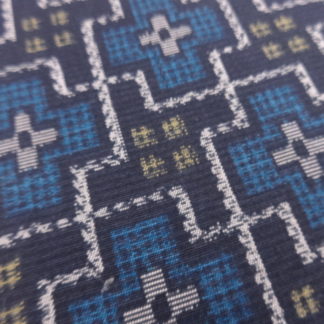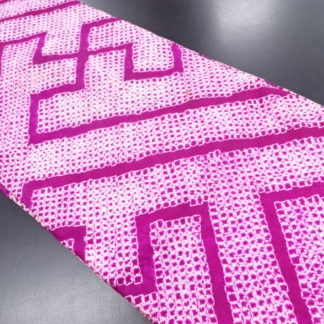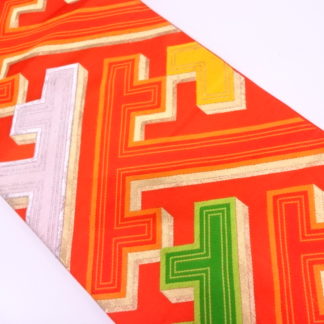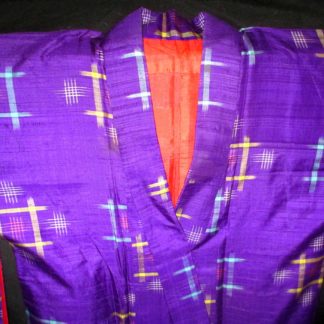Description
Taisho era meisen silk kimono with woven igeta
A lovely kimono from the Taisho era (1914-26 roughly) in meisen silk with a woven igeta pattern, in very good shape for its age.
It measures 140 cm long, 60 cm from the centre to the sleeve edge, and the sleeve drop is 56 cm.
Some moth holes in the lining at the sleeve edges but the outer silk is untouched, and this does not affect it being worn at all. Considering it is going on 100 years old, it is in great shape!
• Igeta: One of the kimono patterns. It looks like the mouth of a Japanese traditional well, which looks rather like a noughts and crosses (tic tac toe) grid
• Meisen: Meisen silk, generally crisp and supple, is one of the Japanese silks fabricated by weaving pre-dyed threads, utilizing the tie-and-resist ikat technique (ikat is an Indonesian term widely utilized to refer to this technique).
In this process, the threads, silk or cotton, are first stretched on a frame. Selected design areas are tightly bound to prevent the dye from penetrating and the hanks of threads are immersed in the dye pots. The bound portions of the yarns resist the dye and when woven, as a result of the threads not being perfectly aligned, create shapes with charmingly uneven edges.
Other Japanese textiles that are made with variations of this technique are cotton kasuri,omeshisilk and tsumugi silk. (described below).
Meisen silk was a popular fabric for casual kimono from 1910 to 1950, in part because it was more affordable, and in part because the designs, frequently drawing on Western influences, seemed adventurous and innovative. Even today they retain a contemporary sensibility.
• Taisho Roman: Design characterised by the modern and romantic fashion mixed Japanese and European cultures in Taisho era.
The Taisho Era (1912-26), sandwiched between the boldly modernizing Meiji Era (1867-1912) and the militarist tide of early Showa (1926-1989), deserves more recognition than it gets.
Taisho is Japan’s Jazz Age. Can it be summed up in a phrase? It often is:ero-guro-nansensu — eroticism, grotesquerie, nonsense.
The term “Taisho Roman” refers to the cultural stylings of the Taisho Period of Japanese history (1912-1926), combined with the shortened form ‘romantic’. An appropriate English translation might be “romantic vintage”.
In terms of wafuku, Taisho Roman often begins with Taisho-era kimono, or kimono that have similar visual cues, such as bright colors and/or large, bold designs. The kimono is then heavily accessorized with elements of Western fashion from the 1920s, and occassionally touches of the 1910s or early 1930s.












Reviews
There are no reviews yet.